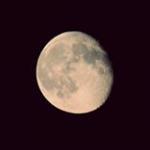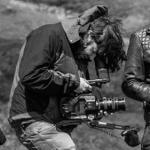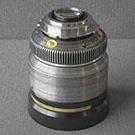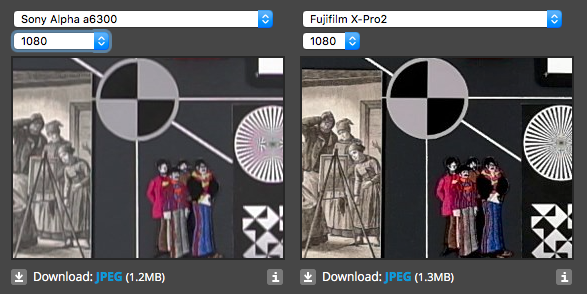Leaderboard
Popular Content
Showing content with the highest reputation on 04/09/2016 in all areas
-
So who uses noise reduction?
Bioskop.Inc and 3 others reacted to Mattias Burling for a topic
I just got a bit curious and thought it could be interesting to get a sense of how many uses noise reduction? Be it Neat Video or Red Giant Denoiser or what have you. For work I have used it on a project in the past and on my first couple of t3i videos. But other than that I never use it. In all my +200 youtube videos there is no noise reduction. Be it the BMPC4K, D16, Sonys a7sii, etc, nope dont use it. I guess I don't think its worth the time, a little noise never killed anybody. I don't even have my Neat Video license installed anymore. So what do you guys say, sometimes, never, always?4 points -
I am for MJPEG but imo, the noise reduction in video mode is far more important now as its completely cancerous. Its impossible to film above 800ISO in 1080p without having a video footage that looks like its from 1997. 2160p can do about 1600ISO before it looks awful, the NR seem to cause serious issues in destroying details in dark areas too. Which means you cannot underexpose at all before ending up with ruined images with lost details and the camera overexposes quite easily and balancing this literally requires a degree in science...4 points
-
I haven't even acknowledged those comments because he's deluded. There's nothing wrong with his camera. My pocket reacts exactly how his does - as does every other bmpcc. All his actions do is increase the price of future products from BM because they have to add costs for the idiot factor. BM's customer service personel:- "We got another email from a customer expecting his camera to perform with a iphone torch as lighting. What should I do boss?" BM's customer service manager:- "just send him another one. Don't bother wasting Mr Petty's time. The sooner we get his unit back, the less time he can spend shooting crap 'low light tests' and uploading them to youtube"4 points
-
Petition for Samsung NX1 hack
vaga and 3 others reacted to Soul-Brother for a topic
I've pledged. The modders are fantastic people. lets help them. Remember they are putting their own time into this. Perhaps those who were enthusiastic about giving donations, at the top and throughout this thread, would like to help .4 points -

Petition for Samsung NX1 hack
Hanriverprod and 2 others reacted to Marco Tecno for a topic
I agree that a very big thing for nx would be turning off the terrible nr. And when I say 'off' I mean really off, completely. Both in jpg pics and - much more important - video.3 points -

Camera Upgrade 4k, Blackmagic, or Not?
TheRenaissanceMan and 2 others reacted to Oliver Daniel for a topic
I agree. I think it will be an Ursa Pocket, as the Ursa range is replacing the sensor in a box designs of before. Whatever market gap there is though, BM will be on it. In terms if a camera purchase, I've also been on an A-cam yo-yo. I think an investment now really does need 4K, as in two years, clients will be asking for it as standard. The issue I have with 4K is that most of the manufacturers have bolted on thin and brittle 4K at the expense of better HD.This is also affecting high frame rates. We get brittle 4K with mediocre to poor HFR performance. The A7SII is a good example of this. 4K is ok, yet the HD HFR modes are much worse in quality. This camera screams for HD 10-bit, but it's skipped for thin low bitrate 4K. A major purchase must cover every required area at a high quality, and because clients in the UK don't care what you shoot on (as long as it looks high quality), you can get away with brands under the attractive RED logo. I love the images from the Ursa 4.6k, however the camera is still pretty chunky (needing to invest in bigger tripod, slider etc) and the HD HFR is far from ideal for professional work. Pre-NAB, the ideal camera that could last years in a professional environment is the Kinefinity Terra (if the image quality remains high). Small, light, modular form factor. 5k 60fps. 4K 100fps. Raw and ProRes. Global or rolling. Good price. Organic aesthetic. Can be speed boasted and have any mount. LUT support. SSD's. Seems like a no-brainer that will last a long time. If anyone is going to NAB, please report from the Kinefinity stand.3 points -

Petition for Samsung NX1 hack
samuel.cabral and 2 others reacted to Gerbert Floor for a topic
I was just thinking about pledging, vasile and otto should just work on their hacks without fear of bricking the camera. I would definitely pay 20 euro's and more (if we see more results) and I don't even own the camera (yet)3 points -

Petition for Samsung NX1 hack
ikola and 2 others reacted to /Chop N Shoot Films/ for a topic
Is MJPEG encoding still on the table?3 points -
Filmmaker is the standart text that the forum places there, mr professor. If you take a look at bioskops file, open it in photoshop, turn off color noise removal and push one stop (iso 1600) you will see the same noise you have. You can take any camera and put it into equivalent iso (iso 4800-6400 for fullframe) and you will see the same noise in shitty light. Have fun, I've seen this noise debates on dpreview for years, it's always the same story. a cookie if you need one for your ego.3 points
-
Often it's cheaper to just send a replacement than try to diagnose the problem only for the customer to complain online. I've yet to send examples of what I've found with my camera since I don't think the issue is really an issue unless the footage is pushed heavily. I'm on the fence. I always felt amazed how much the pocket could do, and know that what I'm seeing is likely a firmware fix rather than a physical problem. because i know how good they are with customer service I'm happy to sit back and see. if in 1 -2 months - or 8 months for that matter I feel the camera isn;t doing what it should I'll get in touch with them.2 points
-

Camera Upgrade 4k, Blackmagic, or Not?
Mattias Burling and one other reacted to Jimmy for a topic
I wouldn't drop any cash on a camera until after NAB... Even if you can't wait for the announced camera to ship, you might find price drops on the older cam you want. As things stand, I'd agree with the suggestion of the 1DX II... Will be a low light beast too and seems quite future proof. I'd also think about an fs700/O7Q combo... The transition from the fs100 will be easy and it has alot of power2 points -
So who uses noise reduction?
Zach Goodwin and one other reacted to Mattias Burling for a topic
I still dont use it Ive never used it on TV either accept for one time. This is my ecperience as well. Thats why I started the thread. Never knew people used it on everything. For me its an emergency tool, like stabilization, never use that either unless I absolutely have to. Guess Im becoming old school2 points -

Camera Upgrade 4k, Blackmagic, or Not?
Emanuel and one other reacted to TheRenaissanceMan for a topic
I think a used C300, Red One MX, or Battle-tested Kinemini 4K are your best options. Kinemini has the best overall IQ and flexibility; RED has brand recognition and 4K; and the Canon is super popular with clients and offers a solid image with little fuss. The Ursas are really cool and create great images, but imo aren't quite ready for prime time yet...and that's coming from one of the biggest BM apologists out there.2 points -
Where did all the single focus solutions come from?
Bioskop.Inc and one other reacted to Brian Caldwell for a topic
If you're doing a wide angle Iscorama-style attachment with a large diameter front, then my statement about the variable diopter being "easy" obviously needs amendment, since the mechanics does become much more difficult. Although I'm a big fan of big lenses, they tend to require exotic/expensive items like precision linear bearings to keep them moving straight and without play. Maybe not entirely relevant here, but its interesting the the new Cooke anamorphics also use a pretty basic variable diopter focusing scheme, although the net power is negative rather than afocal: http://pdfaiw.uspto.gov/.aiw?PageNum=0&docid=20140300973&IDKey=735679DAC5C4&HomeUrl=http%3A%2F%2Fappft.uspto.gov%2Fnetacgi%2Fnph-Parser%3FSect1%3DPTO2%2526Sect2%3DHITOFF%2526p%3D1%2526u%3D%25252Fnetahtml%25252FPTO%25252Fsearch-bool.html%2526r%3D5%2526f%3DG%2526l%3D50%2526co1%3DAND%2526d%3DPG01%2526s1%3Diain.IN.%2526s2%3Dneil.IN.%2526OS%3DIN%2Fiain%252BAND%252BIN%2Fneil%2526RS%3DIN%2Fiain%252BAND%252BIN%2Fneil2 points -

Camera Upgrade 4k, Blackmagic, or Not?
sudopera reacted to Oliver Daniel for a topic
Zach is in the X-Men and therefore defies all expectations. I'm also interested in the 360 cam stuff. I expect Sony to release 458 of them in the next year.1 point -

Camera Upgrade 4k, Blackmagic, or Not?
Zach Goodwin reacted to Cinegain for a topic
They had some new breakthroughs recently...1 point -

Camera Upgrade 4k, Blackmagic, or Not?
Jonesy Jones reacted to Oliver Daniel for a topic
Awesome Mr. Jones I feel these guys at Kinefinity have a hard time with the West, as Chinese products kind of have some cheapo taboo and they don't have a decent international marketing and sales channel. It also doesn't help there's a lot of animosity online about them, mostly with those who own an expensive camera like a RED. Those who do own Kine cameras say the support is great and the products are top quality. These would be good questions: 1. Are there plans to expand their international sales channel and expand dealership of their cameras? 2. How do English speaking countries get support for the cameras (with a language barrier?) 3. Do they have a license to use ProRes and if not, when do they expect to get it? 4. Does the global/rolling switchable shutter work in any protoypes/models? If so, is there a significant quality difference? (BM failed here as GS was not good enough). 5. Is there any loss in quality using Hi Speed modes, and if so, what will be compromised? (Resolution, noise, moire, aliasing). 6. Is every frame rate/resolution on the cameras available in both Raw and ProRes? 7. What is the functionality of the KineGrip? How long can a Sony battery power the camera for via the grip? 8. How long does the Terra take to boot? 9. How much more weight will the KineBACK and regular V-lock add to the overall camera? 10. What is the native ISO? 11. If I was to pre-order the camera, when can I expect to receive it? 12. What cost are we looking at if I order the camera with a Kinemount and an extra adapter? (Like EF or PL)? 13. Does the 6k model have a 5k mode? If so, why not? 14. Are lower resolutions and Hi-Speed modes crops of the sensor or can they be used with the full Super35 image area? 15. What is included in the Wi-Fi functionality? What can we control? A lot of questions. But I love the look of the Terra and there are many unanswered questions.1 point -

Blackmagic Micro Cinema Camera
Zak Forsman reacted to MattH for a topic
This is blackmagic. Nothing is around the corner. Even if they anounce it tomorrow you wouldn't get your hands on one for another year. I think the differences are pretty surface level. The pocket can be used on its own, the micro needs a monitor or viewfinder (unless you're using it as a go pro or crash cam). The micro does 60p, In the future it may do global shutter. The micro has a bigger battery. The micro has an expansion port that someone might design a remote control for at some point. The micro (I think) has slightly less rolling shutter. I think thats pretty much it.1 point -
Petition for Samsung NX1 hack
Pavel Mašek reacted to Otto K for a topic
@Pavel Mašek yes, I will make a usable gui in next few weeks (I first have to decide on what's best solution as it should be a single gui for everything, not just this "rooting").1 point -
Now that the dpreview is out, it's easier for many of us to do some more comparison. http://***URL removed***/reviews/sony-a6300/5 Of course the A6300 blows away the X-Pro2 with it's 4K, log profile and other stuff, but looking at the 1080p samples is interesting: The X-Pro2 looks much more detailed (at some points over sharpened), but all in all it looks really nice, especially if you know how older Fuji cameras did. Any other thoughts/news?1 point
-
1 point
-
Camera Upgrade 4k, Blackmagic, or Not?
Jonesy Jones reacted to mercer for a topic
Yeah that is kinda my joke about the Ursa Minor... Basically pocket 2 that will combine the qualities from the pocket with the qualities from the mini 4.6. But a Pocket 2 and a separate Ursa Nano would be well received as well.1 point -

Petition for Samsung NX1 hack
SMGJohn reacted to samuel.cabral for a topic
Also curious if we can dream about a new encoding option.. But i agree that disable the auto noise reduction from the system is more important now.1 point -
My review of the JVC LS300
TheRenaissanceMan reacted to Mattias Burling for a topic
I was packing up the loaner thats shipping back to JVC when I thought I would do one last thing. Some experimenting with the Cine Gamma. The J-Log is really great. It has a nice roll of and I love using it specially on bright days with a high dynamic range. But in dim light, specially low contrast, it doesn’t withstand grading very well. The noise can turn very ugly and FPN if not careful. So far my fix for it has been to expose down. If its dark, let it be dark. This isn’t a night for day camera. Today I tested something else. Anybody that uses Sony and S-Log knows that in many low contrast situations its better to switch to "Cine Gamma”. Specially to preserve skin tones. And it seems JVC is no different. I shot some clips of myself in a mirror. There is no direct light hitting me, its pretty dim. If you look at my sweater, on the right arm, you can see how the J-Log has a nicer roll of, while the Cine Gamma has a harsher clip. But you can probably also see how much nicer the skin gets, specially on the shadow side. There where less banding on the wall as well. And the J-Log is just about to fall apart after the grade and a WB correction. The Cine Gamma had correct WB in camera but still feels like there is some more leverage there. J-Log Ungraded J-Log Graded Cine Gamma Ungraded Cine Gamma Light grade Cine Gamma Graded to my liking So a quick unscientific conclusion is, J-Log in bright and HDR light. Cine Gamma when uncertain. Now I can’t wait until my own LS300 gets here, because I need to give the Gamma settings and Picture Profiles a thorough run through. There is for example a WDR setting that I want to fool around with. Cine Gamma WDR Ungraded Cine Gamma WDR Light Grade1 point -
1 point
-

Panasonic GX80 - 5 Axis IBIS works on video!
mercer reacted to samuel.cabral for a topic
Hey guys, check this out! If it only had a mic input... I think i'll wait for the gh51 point -
So who uses noise reduction?
TheRenaissanceMan reacted to mercer for a topic
Stop shooting with ISO 6500 on a t2i and you won't need noise reduction. ?1 point -
Much Canon bashing here. Why? Go buy something else if you hate Canon. I for one will be picking up a 1DX Mk II. If it's horrible, I will sell it. But most likely it's going to be with me for a few years. Sony's are obsolete in six months... Well resale value is anyway. That's why I get my monies worth out of them, and then sell and get the next model. Relax. PS: I also bet AR will be getting a 1DX MkII within the year;-)1 point
-

NX500 hopes and dreams
Soul-Brother reacted to Marco Tecno for a topic
as said in the other thread, you should definitely take a look here: http://***URL removed***/forums/post/575727991 point -

Canon 80D video quality still atrocious
Zach Ashcraft reacted to Jimmy for a topic
Didn't you just buy a XC10? I think you bad mouth Canon to push the prices down so you can buy them on the cheap I'd place money on you owning a 1D-X II within the year!1 point -
Has Sony made a baby Alexa?
Zach Goodwin reacted to Mattias Burling for a topic
I made some luts for the way that I expose s-log that makes skin look perfect with just a drag n drop. I made a couple different once with a kodak and fuji look. But if the WB is of by just a hair, it turns to garbage.1 point -
Camera Upgrade 4k, Blackmagic, or Not?
Volker Schmidt reacted to Mattias Burling for a topic
4K is not needed just yet. The ursa mini 4.6k is great in lowlight. All the cameras listed have flaws. So imo, get the one that suites your style of shooting the most. Do you need speed, audio, handheld? Those are the questions I would ask myself.1 point -
I still don't get why anyone is using auto white balance. I see 3200K 5600K and rarely 4300K and that's it.1 point
-
Camera Upgrade 4k, Blackmagic, or Not?
Jonesy Jones reacted to mercer for a topic
If I had a $5000 camera budget, I would raise another grand and get the Canon 1DXii. 4K up to 60p. From what I hear, clients love Canon and it will be a workhorse for the next 5 years. And then I would raise another $1500 and pick up the BMMCC, a screen and a cage.1 point -

Has Sony made a baby Alexa?
kidzrevil reacted to Oliver Daniel for a topic
I can confirm after so many shoots and so many tests that Sony white balance on the A7 series DOES NOT WORK PROPERLY. How it gets into the working cameras is beyond me. I think this is the main reason why A7 colour science seems a bit like puke. FS7 and F55, much better. These cameras skin tone seem more bronzed, muted, not plastic at all. They still need much more work than other brands to get right. I'll probably always keep an A7S whatever version though as its a superb tool to have in the bag, always. Sometimes the "crappy" colour is ideal. Battery life is shocking though. They need to sort this.1 point -
Petition for Samsung NX1 hack
Pavel Mašek reacted to Otto K for a topic
People asked about possibility to switch between EVF and LCD during video (apparently not working on NX1). Since I have NX500 I cannot really switch anything but what is described here works as described st app bb [lcd|evf|tv][on|off|osd|video] For example, to show only clean video on back LCD: st app bb lcd video To show only OSD (without video): st app bb lcd osd To turn it off completely: st app bb lcd off To show everything as normal: st app bb lcd on Now, someone with NX1 could try and report back if these things work and if this can solve the problem of switching the LCD/EVF during video. https://github.com/ottokiksmaler/nx500_nx1_modding/blob/master/Control_LCD_EVF.md1 point -
I have run for 30 mins @ 160 mbit with no problems1 point
-
No one in high end fashion will discard a phase one mf camera for the benefits of having video functions of a canon or nikon. in high end fashion the stills are done one day on medium format and the video another - on an Alexa or Red. Usually with the same creative director, but two different shooters. That said, a lot of the guys I've dealt with in the high end fashion world are stills photographers who now shoot or more often direct video. I can;t see them ever moving to a canon for the benefit of being able to shoot low quality video - not until they offer a medium format sensor and lenses that match or outdo the offerings from Phase One. CCD has only just started to be matched by cmos in terms of image quality in the Medium format world (the IQ2-50, and the IQ3-100 - both are Sony developed sensors). - due to the smaller market there was less demand for development of cmos sebnsor of medium format size than there is in the dslr market. - tech always moves quicker in the consumer sector. CCD tech reached its peak 5-10 years ago and even now my Dalsa 56mpx sensor in my leaf aptus 10-ii (released in 2008) delivers an image that makes my a7rii cry. Dynamic range is around 3 stops less than the a7rii but it's the 16bit colour, and refinement of overall image that has the edge on the dalsa sensor. not to mention how good Phase One's 'Capture One' software is at processing the 16bit raw files out of the sensor. Main reason for lack of live view is due to the number of pixels they're dealing with, and the prehistoric processing (when compared to the processing within an a7rii or a dual digic7 canon camera) - the buffer on even the fastest mf backs only permits around 1 frame per second for 50mpx-80mpx sensors. I think this is the main reason for lack of live view. I'm definitely looking at the kipon medium format to Fe-mount with excitement. They won't give a genuine medium format look, but will get close. but to obtain worthwhile results it'll be down to what MF lenses you stick on the front. atm there is only really the hassy 110/2 that really offers an exciting proposition to me - a resultant 80mm/1.4 will be magic. however probably wont come close to an otus 85/1.4 and will only be slightly cheaper. I'm certain there will be a 50mpx fixed lens camera from sony using the iq2-50 sensor some time soon. then naturally a interchangeable lens version a year later!1 point
-
Petition for Samsung NX1 hack
André Eriksson reacted to Otto K for a topic
You are not going to brick your camera this way. Also, bring another SD card - once you pop out your SD card with mods (or format it) the camera acts as it was never modded. Best of luck shooting1 point -

So who uses noise reduction?
Zach Goodwin reacted to Liam for a topic
I've fiddled with a free way to kind of roundabout denoise a bit.. (basically find the edges and slightly blur everything else). it was probably more educational than functional. though it definitely helped - the t3i has enough artifacts that it really made quite a difference. I would use it more for sure if I had the time. less likely to use it on a portrait, when the loss of detail and texture starts to hurt. and pretty much need to add grain1 point -
So who uses noise reduction?
Bioskop.Inc reacted to j_one for a topic
I used to think noise reduction was the key and holy grail to professional standard delivery when I first started handling footage in post. It helps sometimes, but now I'm so used to making sure I'm exposing with base ISO and adequate light to avoid the need altogether. I can't stand the plastic look that sometimes comes from it, and it really bogs down post-time for all the system resources it eats up. I hate 'color noise' or the digital blotches that come from compressed video. Guess that's why I hate seeing rainbow moire but can live with simple aliasing. Desaturating shadows helps. And as you said, a little noise never hurt anyone.1 point -

Panasonic GX80 - 5 Axis IBIS works on video!
Xavier Plagaro Mussard reacted to Don Kotlos for a topic
After searching a lot on the internet and doing a little bit of inference I think I understand better what is different between the IBIS of Olympus and Sony. Olympus utilizes a spring to stabilize the sensor in the central position and coils/ magnets move the sensor around. Sony replaced the spring with strong permanent magnets and also uses coils on the sensor plate to move it around. Since the FF is much heavier the strong magnets required a very strong magnesium alloy case that does not bend and the inclusion of a ball bearing system. Olympus description (misses the spring). Lesnumeriques Sony engineers interview Roger Cicala A7ii teardown The Phoblographer IBIS discussion So yes, both of them use voice coils to move the sensor around but olympus is using a spring based system for the base location whereas Sony uses permanent magnets. Sony claims that only their system can support heavier sensors and offers much finer control of the movement. From my personal tests of both systems, it is true that the IBIS from Olympus is still better. What my tests above didn't show is that after using the Sony 24-70 f/4 (got it just yesterday) with OIS the Sony gets really really close the the Olympus. So I believe the main difference between these systems is that Sony's IBIS does not compensate yaw and pitch as well as Olympus IBIS. That would agree with the experiences of @natluma with non OIS lenses on GX85 (sorry @mercer ) . So in short Olympus IBIS is better and that could be because 1) Permanent magnets do not compensate Yaw & Pitch as well as a spring based system 2)FF sensor is much much harder to move around or 3)Fine-tuning of IBIS settings. A combination of those is most probably the case...1 point -
You know what I think makes a really good Formula 1 or MotoGP driver? That he's as good in the field as he is with his team of engineers. He not only needs to know his personal limits, he needs to know where his machine shines and where there's room for improvement to squeeze out that little bit of extra oompf. Albert Fast is one of these folks that knows the limitations of his gear and knows what to do in post processing to make it go that much further. I feel like that's the real struggle. It's like flying a plane, everyone can make a decent take-off, just throttle up and yank the yoke... pulling off a smooth landing is a 2nd. You've got to have a feeling and understanding for it. It's about putting the puzzle pieces together, you've got to have that oversight. I'm still trying to get to that place with getting my looks down, figuring out the whole deal with all these different LUTs, techniques and methods especially, since I've been shying away from them except for getting quick impressions how different looks would suit certain footage and then just tinkering away from scratch, which tends to get a little time consuming, but I also don't want to throw in a LUT and look like a Instagram hipster. Tough to find that balance, I salute those who have a natural feel for it! One of my fav looking vids to come across over the last year, must have been this one by Ed on the F35, to me that's just gorgeous synergy of men and tools.1 point
-
Larger CCDs seem to have trouble with liveview/video, no idea why, but the CCD era is over. The focal reducer from baveyes will be released in April (that's what they told me at Kipon)1 point
-
Canon 80D video quality still atrocious
Tony Anastasi reacted to Policar for a topic
I even bet the 5D4 won't beat the A6300, but I'm not sure it needs to. It won't have more resolution (almost certainly much less) but it also won't overheat in the middle of shooting a once-in-a-lifetime BTS interview with Tom Cruise or something. I have friends who do that kind of stuff and they've had to switch back to cameras with a worse image (despite spending more to get less) because A-listers have little patience and probably don't know what aliasing is. And so.... this argument is fruitless. The 80D is a great low end "pro" camera because it's reliable and the image is good enough to sell (the 7D was used extensively on national ads and still occasionally used as a B camera on major tv series). For resolution enthusiasts, there are lots of other options, though. So are you an artist or a hack? Sounds like you're an artist. Not me. I'll take hack if the day rate is higher and it's an amicable team. Even on my own recreational projects I don't want to waste time in post or on set. But kudos to people on both sides. Just because I don't have the finances or financial freedom to up my game doesn't mean I don't want to. Artists and hacks both have valid motivations, and even Spielberg money won't bridge that gap. Good luck convincing anyone to switch sides because they won't easily.... The A6300 probably has a sharper image than the Alexa 65, forget a Canon dSLR. If what you're after is technical excellence you've found it. Sure there's tons of skew, it breaks down on set, and the color is hideous unless you control it carefully–but the resolution is breathtaking and with enough patience and care in lighting you can work around the rest. But some of us are broke and need that paycheck. And worse yet we're lazy. Living wage is $80k/year in my market. Once that's paid for, I'll consider trading up. For now... if it pays, that's what counts. So I salute the 80D guys. I even want one because it seems so easy to use I can save on crew and pay myself more. But I also think it's sort of criminal that we still put up with such a soft picture, and that Canon won't offer more. All I need is GH2 sharpness and 80D everything else and I'm sold. Weird... really weird... that that isn't available even now. It should be.1 point -

Lenses
Inazuma reacted to TheRenaissanceMan for a topic
If it'll mount on your camera, the Minolta 35mm 1.8 is an excellent performer. If you need it to fit EF, you can get a lens tech to convert it for $150. If that sounds like too much hassle, the Contax Zeiss 35mm 1.4 is a pricey but excellent choice, as is the Leica R 35mm Summicron.1 point -
Hey there guys, been a lurker for awhile but decided to chime in on this conversation. I actually had an opportunity to play around with a GX80 (and the PL 100-400) today at my local camera store. They had a rep there who happened to have a copy on hand and he let me use it. I was really impressed with the Dual IS in 4k. Its stabilization is as good as the EM5 II but with the added benefit of resolution. The story wasn't as good when I mounted my Oly 12-40 on it however. There was some sway and shake in the footage when handholding but it didn't look too severe. It would probably be easily stabilized in post. EDIT: Also, he told me that IBIS stabilized video will not be coming to the GX8 via firmware at all. The reason he gives is that the IBIS in the GX8 is spring-based and therefore not compatible with video while the GX80's is electromagnetic.1 point
-

Petition for Samsung NX1 hack
vaga reacted to Pavel Mašek for a topic
Yes, I have noticed that too (especially in 4k), but I thought it is just my opinion. Anyone complained "motion cadence problem" in NX1? I think it is gone now!1 point -
Predictions for NAB 2016???
Kurtisso reacted to Mattias Burling for a topic
Probable A 4K Ninja Star type recorder for us that don't want a monitor, just the 4:2:2. Hopeful A new BMD camera with a s35 sensor and m4/3 mount (its gold Im telling you).If not m4/3 I guess a EF is ok. Wishful That more brands realize that thin bit 4K isn't worth more than colors, ergonomics, DR, workflow, etc. Something from Digital Bolex that I can preorder1 point





